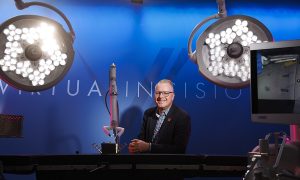Tiny robot’s successful first surgery could have huge implications for space travel

A tiny robot has completed its first surgery in zero gravity on the International Space Station, operated by surgeons approximately 250 miles away.
February 10 saw the first surgery demo on simulated tissue in the lab that’s currently circulating in orbit on the ISS. Surgeons in Lincoln, Nebraska operated the remote-controlled robot, known as space MIRA (Miniaturized In Vivo Robotic Assistant), reports CNN. The robot was developed by a team at the University of Nebraska, led by Nebraska Engineering professor Shane Farritor.
A SpaceX Falcon 9 rocket gave spaceMIRA a ride into orbit on January 30 from Florida’s Cape Canaveral Space Force Station and the robot arrived at the space station on February 1.
Looking forward, this could be a huge step forward for human space travel, offering the possibility to deliver complex medical procedures even when in orbit. It could also make a huge impact in establishing access to medical care in remote areas down on Earth too.
When it comes to space travel, journeying to other planets, like Mars, could take two years for a full round-trip. If medical emergencies happen during that time, this kind of technology could be life-saving.
Meet spaceMIRA, the surgeon from out of spaceWeighing just two pounds, spaceMIRA is about the same size as a microwave, making it the perfect size and weight to be well-suited for space travel. Part of the robot is inserted into the tissue to perform surgery, while using two ‘arms’ to mimic the movements of a human surgeon.
“It gives smaller hands and eyes to the surgeon (on Earth) and allows them to perform a lot of procedures minimally invasively,” said Shane Farritor, cofounder and chief technology officer at Virtual Incision, the startup that created spaceMIRA.
The demonstration on February 10 saw spaceMIRA use one hand to provide tension to the simulated tissue and the other to dissect it with scissors. Six on-the-ground surgeons performed remote tests with the robot, all of which were successful.
One of the major challenges for remote surgery is a delay between commands from the surgeons and the robot, in situations where a one-second delay could prove fatal. spaceMIRA’s delay is about 0.85 seconds, which didn’t present many issues during these tests.
“Five seconds would be an eternity in surgery, and a split second or a half a second is going to be significant. So, this was a big challenge,” Dr. Michael Jobst, a colorectal surgeon who was part of the demonstration.
spaceMIRA is set to make its triumphant return to Earth in the spring.
Featured image: University of Nebraska’s College of Engineering
The post Tiny robot’s successful first surgery could have huge implications for space travel appeared first on ReadWrite.
